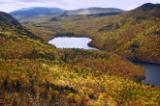 © Pete Saloutos/Panoramic Images (Maine Title Image Large)
© Pete Saloutos/Panoramic Images (Maine Title Image Large)

Conservation Overview
Working in part through Maine’s highly successful Lands for Maine’s Future program, the Beginning with Habitat partners have secured long-term habitat protection on more than 1.2 million acres statewide. Much of this acreage has been conserved in the more than 140 Beginning with Habitat Focus Areas of Statewide Ecological Significance.
Rare Species and Characteristic Habitats
Maine's diverse assemblage of wildlife, plants, and natural communities, and the outdoor experiences we cherish, depends on the availability of suitable habitat. Maine’s vast North Woods encompass the largest undeveloped forest east of the Mississippi, providing habitat for wide ranging species such as moose, black bear, pine marten, and Canada lynx.
This mosaic of diverse physical settings supports a wide diversity of wildlife. Maine has the largest population of bald eagles in the Northeast, and its islands support one of the most diverse nesting seabird populations on the East Coast, including habitat for rare species such as the Roseate and Arctic Tern, Atlantic Puffin, and Razorbill Auk. The state's relatively clean, free-flowing rivers sustain some of the best remaining populations of rare freshwater mussels and dragonflies in the East, host globally rare endemics, such as the Tomah mayfly (Siphlonisca aerodromia) and Roaring Brook mayfly (Epeorus frisoni), and support the recently listed Atlantic salmon DPS (Distinct Population Segment) (Salmo salar) found in eight mid-coast and downeast rivers. Maine's mountains and forested habitats contribute significantly to the global breeding habitat of neotropical migrants such as Bicknell's Thrush and Blackthroated-blue Warbler. The state has some of the best examples of pitch pine-scrub oak forest remaining in New England, hosting a suite of globally rare plants and invertebrates.
Public and Private Conservation Efforts
Recognizing the rapid change in land-use patterns over the past two decades, conservation partners working at the local, state and federal level have conserved those places most cherished to them. At the agency level, these include the U.S. Fish and Wildlife Service, the Maine Department of Conservation, the Maine Department of Inland Fisheries and Wildlife, and Salmon Habitat and River Enhancement (SHARE).
Maine's land-trust community, which comprises more than 95 groups that own 84,274 acres and protect another 1,492,279 acres in easement, is equally important. Collectively, these efforts have dramatically increased the amount of conserved lands from 13.6 million acres in 2000 to 17.2 million acres in 2005.
Threats
The key threats to wildlife diversity in southern and coastal Maine revolve around the state's rapid growth and include land conversion, habitat fragmentation, and poorly planned development. The traditional view of Maine's development status needs revising. In the conventional wisdom, Maine remains overwhelmingly rural, a "place apart" from the vast waves of development sweeping much of the Atlantic Coast. Yet since 2000, the state's growth rate has nearly doubled, and its annualized growth rate now ranks 26th among all states – up from 46th in the 1990s.
Southern and coastal Maine has the highest level of plant and wildlife diversity in the State, as well as the highest development pressures. In a 2001 report, The Brookings Institute found that sprawl – the conversion of rural lands for urban or suburban purposes – in the greater Portland area is occurring at one of the fastest rates in the country. From 1982-1997, the population of the greater Portland metropolitan region grew 17.4% with a 108.4% increase in urbanized land, earning its ranking as the ninth fastest-growing metropolitan area in the country.
Overall, just 23 percent of Maine's post-2000 population growth has occurred in regional hub towns. By contrast, 77 percent of recent growth has taken place in surrounding towns, newer emerging towns, and rural areas distant from traditional centers. As a result, the state is converting extraordinary quantities of rural fields and woodlots to residential uses. From 1980 to 2000, for example, Mainers altered the character of 869,000 acres, or more than 1,300 square miles, of rural land—a territory roughly the size of Rhode Island. In the 1990s only Virginia lost a greater share of its rural land than Maine.






